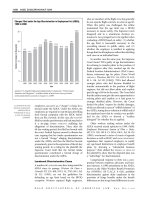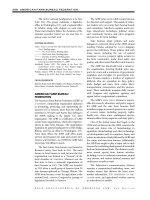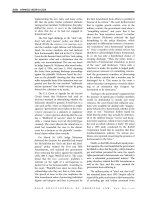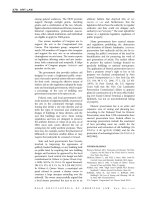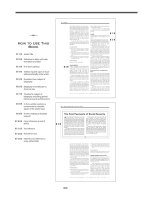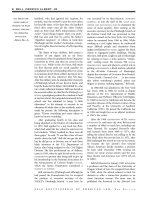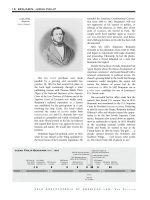Gale Encyclopedia Of American Law 3Rd Edition Volume 2 P55 pptx
Bạn đang xem bản rút gọn của tài liệu. Xem và tải ngay bản đầy đủ của tài liệu tại đây (335.43 KB, 10 trang )
found that a proposed blacks-only law school in
Texas would be unequal to the prestigious and
then-all-white University of Texas Law School
not only in the quality of its tangible facilities
but also in the quality of such intangibles as
reputation and education.
Despite these early victories, de jure racial
segregation of public colleges and universities
did not become illegal until the court decided
BROWN V. BOARD OF EDUCATION OF TOPEKA, KANSAS,
347 U.S. 483, 74 S. Ct. 686, 98 L. Ed. 873 (1954).
Following Brown, schools throughout the United
States were required to adopt desegregation
policies, but
DE FACTO (i.e., actual) segregation
remained in many university systems.
Litigation in the federal courts continued
more than 50 years after Brown. In 1992 the U.S.
Supreme Court held that the state of Mississippi
had failed to satisfy its duty to desegregate the
state university system, in United States v.
Fordice, 505 U.S. 717, 112 S. Ct. 2727, 120
L. Ed. 2d 575 (1992). In Fordice, th e st ate had
eliminated its requirement that blacks and whites
be educated separately, but allowed previously
white schools to remain distinct from previously
black schools and inaccessible to black students.
By the mid-1980s previously all-white schools
in Mississippi remained more than 80 percent
white and previously all-black schools remained
more than 90 percent black. The court found
that the state’s policy of requiring higher
American College Test (ACT) scores for admis-
sion to white schools than to black schools
perpetuated the state’s formerly de jure dual
system because it effectively foreclosed many
black students from attending white schools and
forced them to attend black schools, which
received less funding. The court ruled that
merely abolishing legal segregation and imple-
menting race-neutral policies (i.e., policies that
purport to treat individuals equally without
regard to race) did not satisfy the state’s duty to
desegregate. Instead, the court held, if schools
or school policies maintain racially identifiable
characteristics that can be traced to
STATE
ACTION
, the state may be deemed to perpetuate
former discriminatory practices in violation of
the Equal Protection Clause.
In the wake of Fordice, federal courts re-
examined segregated systems of higher educa-
tion in several states (Knight v. Alabama, 14
F.3d 1534 [11th Cir. 1994]; United States v.
Louisiana, 9 F.3d 1159 [5th Cir. 1993]). The
litigation that resulted in the Fordice decision
continued for more than a decade until the
claims were finally settled Ayers v. Thompson,
358 F.3d 356 (5th Cir. 2004).
Federal Law and Private Institutions In 1964,
in response to the slow pace of racial reform,
Congress passed the Civil Rights Act of 1964,
which prohibited discrimination on the basis of
race (and sometimes gender) in public accom-
modations, federally funded programs, and
employment. Title VI of the act prohibits
discrimination “on the basis of race, color, or
national origin,” in “any program or activity
receiving Federal financial assistance,” which
includes many centers of higher learning in the
United States. Title VI reaches state and private
schools that receive direct federal funding. It also
reaches some institutions that receive no direct
federal aid but that have a significant proportion
of students who do (Grove City College v. Bell, 465
U.S. 555, 104 S. Ct. 1211, 79 L. Ed. 2d 516 [1984]).
Affirmative Action Beginning in the late 1960s,
in response to the
CIVIL RIGHTS MOVEMENT,many
universities began adopting
AFFIRMATIVE ACTION
College Enrollment of Recent High School Graduates, 1970 to 2006
0 10203040506070
Percent enrolled in college
a
a
Persons aged 16 to 24 who graduated from high school in the preceding 12 months.
Includes persons receiving GEDs.
SOURCE: National Center for Education Statistics, Digest of Education Statistics,
2007.
White
Black
Hispani
c
2000
1990
1980
1970
Year
N/A
N/A
63.99
56.19
53.00
2006
68.5
55.5
57.9
61.53
46.33
47.32
49.93
41.83
52.71
52.01
ILLUSTRATION BY GGS
CREATIVE RESOURCES.
REPRODUCED BY
PERMISSION OF GALE,
A PART OF CENGAGE
LEARNING.
GALE ENCYCLOPEDIA OF AMERICAN LAW, 3
RD E DITION
528 COLLEGES AND UNIVERSITIES
policies. Such policies attempt to encourage or
to promote racial equality by ending de jure
inequalities that remain even though legal
inequalities have been abolished. In the begin-
ning, many institutions employed quotas that
reserved a certain number of spots for
applicants of racial minorities. Other institu-
tions considered membership in a racial
minority as one var iable in determining
whether to admit a stude nt.
It was not long before affirmative action
policies came under legal attack as “reverse
discrimination.” The first serious challenge to
affirmative action,
REGENTS OF THE UNIVERSITY OF
CALIFORNIA V
. BAKKE, 438 U.S. 265, 98 S. Ct. 2733,
57 L. Ed. 2d 750 (1978), fundamentally changed
its structure. In Bakke, Allan Bakke, a civil
engineer of Norwegian descent, applied for
admission to a medical program at the Univer-
sity of California. The program in question set
aside 16 spaces for minority students out of a
class of 100. Candidates for the set-aside spaces
did not have to meet the minimum grade-point-
average threshold established for other candi-
dates. Although Bakke’s grade-point average fell
slightly below the minimum, he argued that he
would have been admitted on an evaluative basis
if the set-aside spots had not existed. He sued
the university under Title VI and the Equal
Protection Clause, arguing that the affirmative
action program discriminated against him on
the basis of his race. The U.S. Supreme Court
found that the university’s affirmative action
program violated Title VI because it used strict
racial quotas to determine admission.
The court found that the program also
violated the Equal Protection Clause because it
was not narrowly tailored to meet a compelling
government interest. The court observed that
the program was designed to remedy the effects
of general societal discrimination (a legitimate,
but not compelling, government interest), not
its own specific discriminatory practices, which
might constitute a compelling interest. None-
theless, the court held that the use of race as
one criterion in determining admission does
not violate either Title VI or the Fourteenth
Amendment. In doing so, it did not prohibit all
consideration of race in admission decisions,
noting with approval certain programs that
take race into account to promote educational
diversity.
Following Bakke, programs that set aside a
fixed number of spaces for minority students no
longer constituted an acceptable means of
affirmative action. Most universities that main-
tained affirmative action programs adopted the
type of program approved in Bakke, which
permits the consideration of race in admission
or scholarship decisions in order to encourage
diversity. Some schools introduced scholarships
that were designed to benefit only certain
groups, suc h as students belonging to a
particular race. Beginning in the mid-1980s, as
the U.S. Supreme Court began holding that
affirmative action programs designed to remedy
the effects of past disc rimination would need to
satisfy the same strict standards as other race-
based classifications (City of Richmond v. J. A.
Croson Co., 488 U.S. 469, 109 S. Ct. 706, 102
L. Ed. 2d 854 [1989]), race-restricted scholar-
ships became the focus of lawsuits.
Lower federal courts struggled with Bakke
for years. In Podberesky v. Kirwan, 38 F.3d 147
(4th Cir. 1994), the U.S. Court of Appeals for
the Fourth Circuit considered a challenge to
the University of Maryland’s Banneker Scholar-
ship program, a merit-based scholarship for
which only black students were eligible. Daniel
J. Podberesky, a Hispanic student, qualified for
the Banneker Scholarship in all respects but
race. He sued the university, alleging that the
scholarship program discriminated on the basis
of race. The university countered that the
program was designed to remedy the institu-
tion’s own past discrimination, which had led
to the underrepresentation of blac k students
at the university. The court held that the
Banneker program violated the Fourteenth
Amendment because it was not narrowly
tailored to remedy the effects of the university’s
Shannon Faulkner
sued for and won
admission to The
Citadel, a previously
men-only public
college. She is shown
here (center) with
other new cadets
during orientation
on August 12, 1995.
MITCHELL SMITH/
CORBIS SYGMA.
GALE ENCYCLOPEDIA OF AMERICAN LAW, 3
RD E DITION
COLLEGES AND UNIVERSITIES 529
past discrimination. Similarly, the Fifth CIRCUIT
COURT
of Appeals in Hopwood v. Texas, 78 F.3d
932 (5th Cir. 1996) determined that the affir-
mative actio n program at t he University of
Texas violated the Equal Protection Clause
because the institution could not prove that the
policy was necessary to further a compelling
governmental interest.
The Supreme Court finally agreed to review
its decision in Bakke by granting
CERTIORARI in
two decisions involving the University of
Michigan. In one case, Gratz v. Bollinger, 539
U.S. 244, 123 S. Ct. 2411, 156 L. Ed. 2d 257
(2003), the court reviewed the university’s policy
of giving undergraduate admission preferences
to racial minorities. The real effect of this
program was that virtually all qualified minority
applicants were admitted, but not all qualified
white candidates were admitted. The court
concluded that the program was unconstitu-
tional because it was not narrowly tailored to
further the government’s interest in having a
diverse student body.
In the second case, Grutter v. Bollinger, 539
U.S. 306, 123 S. Ct. 2325, 156 L. Ed. 2d 304
(2003), the court reviewed the University of
Michigan’s law school admissions policy. Unlike
the undergraduate policy, the law school con-
sidered race a “plus” factor among a number of
other factors. The court concluded that using
race as a plus factor was a means of narrowly
tailoring the school’s desire to have a diverse
student body. The result of the Grutter decision
was that many colleges and universities altered
their admissions policies to consider race as one
of the factors for admissions.
Gender Discrimination
Segregated Public Institutions The Equal
Protection Clause does not require states to
satisfy the same strict standards for gender
discrimination as for racial discrimination.
Whereas states are held to a “strict scrutiny”
requirement with regard to racial discrimina-
tion, they need only demonstrate that discrimi-
nation on the basis of gender substantially
furthers an important government purpose.
The men-only policies maintained by the
Virginia Military Institute (VMI) and the Citadel
of South Carolina, have been challenged thro-
ughout the years by women seeking admission.
In the early 1990s, the U.S. Court of Appeals
for the Fourth Circuit considered two unrelated
cases that challenged the legality of men-only
public colleges: Faulkner v. Jones, 51 F.3d 440
(1995), cert. denied, 516 U.S. 910, 116 S. Ct. 331,
133 L. Ed. 2d 202 (1995), and
UNITED STATES V.
VIRGINIA,44F.3d1229(1994),cert. granted, 516
U.S. 910, 116 S. Ct. 281, 133 L. Ed. 2d 201 (1995)
(hereinafter VMI).
The same court reached two different results
in VMI and Faulkner, because Faulkner involved
an individual
PLAINTIFF who had sought admis-
sion to the Citadel, whereas VMI was brought
by the
DEPARTMENT OF JUSTICE and did not involve
a particular student.
In Faulkner, the Court required the Citadel
to admit the plaintiff, Shannon Faulkner,
because Faulkner was a “real live plaintiff.” The
court explained that, although admission to the
school was the only appropriate remedy in a case
involving a live plaintiff, the state might later
develop a parallel program, as recommended in
VMI, or adopt a coeducational policy.
In VMI, the court held that because
“homogeneity of gender” was integral to the
type of leadership education provided at VMI,
maintaining a men-only college substantially
furthered the legitimate public purpose of
providing unique leadership education. It then
held that the establishment of a separate-but-
parallel, state-sponsored women’s college with
substantially the same goals as VMI’s would
satisfy the requirements of the Equal Protection
Clause. Faulkner withdrew shortly after the
school year began, putting an end to any possible
appeals in her case. However, the court did hear
the government’s appeal from the VMI decision
and held that Virginia’s categorical exclusion of
women from VMI denied equal protection to
women (United States v. Virginia, 116 S . C t. 2264).
The court agreed that gender-based classifications
are not completely forbidden by the Equal
Protection Clause, but it stated that Virginia had
failed to provide “exceedingly persuasive justifi-
cation” for excluding women from VMI. In
addition, the court held that the separate-but-
parallel women’s college that Virginia had
proposed violated the Equal Protection Clause,
terming the women’s college a “pale shadow of
VMI” in terms of its educational and leadership
opportunities.
Title IX Eight years after Congress enacted
Title VI of the Civil Rights Act of 1964, it
GALE ENCYCLOPEDIA OF AMERICAN LAW, 3RD E DITION
530 COLLEGES AND UNIVERSITIES
amended the act to extend protection against
discrimination in federally funded programs
to include gender. Title IX of the Education
Amendments of 1972 parallels Title VI and has
been used to attack gender discrimination in
such diverse areas as admissions, scholarships,
discipline, and
SEXUAL HARASSMENT. For example,
in Sharif v. New York State Education Depart-
ment, 709 F. Supp. 345 (S.D.N.Y. 1989), a
federal district court held that the state of New
York could not use Scholastic Aptitude Test
(SAT) scores as its sole criterion for awarding
college scholarships without violating Title IX.
Because girls score an average of 60 points lower
on the test than boys, and because the SAT was
not, and did not purport to be, a measure of
past performance in school, the court ruled
that its use had a discriminatory effect on the
awarding of scholarships without bearing any
relationship to a reward for successful perfor-
mance in high school. In Yusuf v. Vassar Colleg e,
35 F.3d 709 (1994), the U.S. Court of Appeals
for the Second Circuit held that a private college
may have discriminated against a male student
who allegedly sexually harassed a female student,
by systematically applying different and stricter
standards to sexual haras sment proceedings
than to other disciplinary proceedings. In
Franklin v. Gwinnett County Public Schools,
503 U.S. 60, 112 S. Ct. 1028, 117 L. Ed. 2d 208
(1992), t he U.S. Supreme Court held that Title
IX also prohibits sexual harassment in edu-
cational institutions and that teachers who
sexually harass or abuse students discriminate
on the basis of sex in violation of Title IX.
Title IX ’s most visible effect has been in
college athletics. Most colleges and universities
operate men’s and women’s athletic programs,
some of which participate in intercollegiate
competitions administered by the National
Collegiate Athletic Association (NCAA). Title
IX caused a great deal of concern when first
enacted, as many schools were worried they
could not remedy une qual participation by
men and women in various athletic programs
without going to considerable expense or
cutting successful programs to achieve gender
equality. These schools also were uncertain
about the degree of equalizing necessary in
order to avoid lawsuits.
In response, the Department of Health,
Education, and Welfare (now the
DEPARTMENT
OF EDUCATION
) established a three-part test for
determining whether an institution is complying
with Title IX with respect to its athletic program.
An institution has accommodated the interests
of male and female students if it satisfies any
of the three benchmarks:
… intercollegiate-level participation oppor-
tunities for male and female students are
provided in numbers substantially propor-
tionate to their respective enrollments; or
Where the members of one sex have been
and are underrepresented among intercolle-
giate athletes, … the institution can show a
history and continuing practice of program
expansion which is demonstrably responsive
to the developing interest and abilities of the
members of that sex; or
Where members of one sex are under-
represented among intercollegiate athletics
and the institution cannot show a continuing
practice of program expansion, … it can be
demonstrated that the interests and abilities
of the members of that sex have been fully
and effectively accommodated by the present
program (44 Fed. Reg. 71,418 [1979]).
The balance between a university’s interest
in maintaining a profitable and successful
athletic program and its need to comply with
Title IX is a delicate one. In Kelley v. Board of
Trustees, 35 F.3d 265 (1994), the U.S. Court of
Appeals for the Seventh Circuit addressed a
typical case involving these competing interests.
In Kelley, the men’s swim team at the University
of Illinois sued the university for violating
Title IX after the school cut the men’s, but
not the women’s, swimming program in an
attempt to eliminate unprofitable athletic pro-
grams and to reduce its budget deficit. Although
neither swim team was popular with spectators
and both programs were historically weak, the
university did not cut the wome n’s program
because its legal counsel advised that doing so
would violate Title IX. The court ruled that
eliminating the men’s program, but retaining
the women’s program, did not violate Title IX
even though the school treated the two programs
differently.
Title IX continues to have many critics, but
the effect it has had on women’s athletics is
practically unquestioned. Twenty-four years
after the enactment of Ti tle IX, the number of
female athletes at the Olympic Games in Atlanta
had risen to 287. The interest among spectators
was almost startling, especially because women’s
athletics had suffered for years in order to
garner support. About 65,000 fans watched the
GALE ENCYCLOPEDIA OF AMERICAN LAW, 3RD E DITION
COLLEGES AND UNIVERSITIES 531
women’s soccer team in 1996 win the gold
medal, and another 35,000 spectators watched
the women fall in the finals of the softball
competition.
Interest in women’s sports continued to
increase throughout the 1990s. Despite the
formation of several professional women’s
basketball leagues, few were successful. This
changed in 1997 with the establishment of
the Women’s National Basketball Association
(WNBA), which garnered support from the
established National Basketball Association.
The league has had unprecedented success,
including maintaining contracts with television
networks that show the games. The focus on
women’s athletics expanded to a national scale
in 1999, when the United States women’s soccer
team won a stunning victory in the World
Cup competition. Neither the men’s nor the
women’s soccer teams had had success in
world-class competition, and the women’s
victory transformed many of the female athletes
to celebrity status.
Few question that these events would have
occurred were it not for Title IX. Women’s
college basketball, probably the highest-profiled
sport for female athletes, typically receives equal
attention as the corresponding men’s programs.
Likewise, softball and soccer have gained
popularity among individual schools as specta-
tor sports. Nevertheless, college and universities
continue to pour extensive resources into larger
men’s program, especially football and men’s
basketball.
Many athletic departments note that these
men’s programs earn more revenues based
upon a much larger fan base, so the support is
justified. Athletic departments often chose to
drop minor men’s sports instead of adding
women’s sports, citing the budgetary con-
straints. Advocates for women’s programs
counter that cutting the budgets of these
programs would not likely hinder the revenues
significantly and that it would allow athletic
programs to both add women’s programs and
retain smaller men’s programs.
Policies under the administration of Presi-
dent
GEORGE W. BUSH came under fire from
supporters of women’s athletics. During his
campaign, Bush stated his opposition toward
any racial or gender quotas, and some felt that
this policy could cause conflict with Title IX. In
2002 the secretary of education established the
Commission on Opportunity in Athletics, which
issued its final report on February 28, 2003. The
commission found that opportunities should be
improved for all competitors, however, women’s
groups claimed that the report undermines the
importance of improving opportunities for
women’s programs specifically.
A report issued in 2005 by the Department
of Education caused further controversy. The
report suggested that colleges and universities
could gauge interest in men’s and women’s
sports through the use of surveys. Women’s
groups and others criticized the report, while
other groups, including a national association of
wrestling coaches, applauded the report.
President
BARACK OBAMA has expressed strong
support for Title IX. InMarch 2009, he established
the White House Council on Women and Girls,
which will consider a number of issues related
to women’s rights, including the rights pro-
tected by Title IX.
Academic Freedom: The Right to
Speak Freely
The First Amendment prohibits the federal and
state governments from infringing on freedom of
speech. Freedom of speech, which is central to
academic freedom, is highly prized on college
and university campuses. At the same time, most
educational institutions recognize the impor-
tance of maintaining an atmosphere in which all
students enjoy equal educational opportunities
and freedom from discrimination. The need to
balance differing individual rights has led many
universities to enact policies purporting to
regulate or discipline certain types of speech,
and was the focus of many First Amendment
cases in the 1980s and early 1990s.
Racially and religiously motivated acts of
VANDALISM, intimidation, and violence on college
campuses began to attract increased attention in
the mid-1980s. Much of this activity involved
incidents such as the following:
n
A fraternity fund-raising “slave auction”
featuring fraternity members in blackface
who were “sold” to provide services to
bidders
n
The distribution at a state school of leaflets
warning, “The Knights of the
KU KLUX KLAN
Are Watching You”
n
A poster made by a student and hung on
her dormitory room door, listing “homos”
GALE ENCYCLOPEDIA OF AMERICAN LAW, 3RD E DITION
532 COLLEGES AND UNIVERSITIES
as a category of people who would be “shot
on sight”
In response, many universities adopted
policies that prohibited speech and conduct
that caused offense or interfered with educa-
tional opportunities based on any number of
characteristics, especially race, national origin,
gender, and religion. The Univ ersity of Michi-
gan adopted a typical policy on discrimination
and discriminatory harassment that became the
subject of a lawsuit in 1989. In Doe v. University
of Michigan, 721 F. Supp. 852 (1989), the U.S.
District Cour t for the Eastern District of
Michigan examined this policy and determined
that it violated the First Amendment because it
was vague and overbroad—that is, it was
unclear about the scope of the speech that it
would affect and thus potentially encompassed
constitutionally protected speech. Doe was filed
by a graduate student who feared that his
theories about genetic bases for differences
between men’s and wome n’s relative abilities
to perform certain tasks would be regarded as a
violation of the policy were he to discuss them
in class because some students might regard
them as sexist and offensive.
The court agr eed that the university policy
violated the First Amendment and had a
“chilling effect” on the free exchange of ideas.
The court observed that the policy certainly
applied to speech that would not be constitu-
tionally protected, such as imminent threats of
violence, but also swept under its umbrella
speech that might be controversial or even
offensive but otherwise constitutionally pro-
tected. “It is firmly settled,” noted the court,
that under our Constitution the public
expression of ideas may not be prohibited
merely because the ideas are themselves
offensive to some of their hearers. These
principles acquire a special significance in the
university setting, where the free and unfet-
tered interplay of competing views is essen-
tial to the institution’s education mission.
The court then observed that because
Michigan’s policy was so vague that it encom-
passed even constitutionally protected speech,
and because this vagueness led to the potential
for arbitrary enforcement, the policy was
unconstitutional.
First Amendment protection is not limited
to the classroom setting alone. In Iota Xi
Chapter v. George Mason University, 993 F.2d
386 (1993), the U.S. Court of Appeals for the
Fourth Circuit held that George Mason Univer-
sity, a state university, had violated the Sigma
Chi Fraternity’s First Amendment rights by
suspending its privileges as a university organi-
zation after the fraternity held an event, called
the Ugly Woman Contest, that depicted women
in a particularly degrading manner. The court
held that skits, like motion pictures, movies,
theatrical productions, and nude dancing, are
a form of expression that are entitled to First
Amendment protection.
Public university professors and employees
also enjoy First Amendment protection, but as
workers in the public sector they are subject to
certain limits. Unlike private-sector employees,
who may be disciplined or terminated for nearly
anything that is not prohibited by state or federal
law, public-sector employees may not be disci-
plined on the basis of their speech if the speech
involves a matter of public concern. The state
may discipline an employee if it can show that it
would have done so regardless of the speech, or
if the speech actually interfered with the effective
fulfillment of public responsibilities.
In Jeffries v. Harleston, 52 F.3d 9 (1995), the
U.S. Court of Appeals for the Second Circuit
held that the City College of New York could
reduce the term of a black studies professor’s
chairmanship based on an off-campus speech
he had made (which had includ ed derogatory
remarks about Jews) about bias in the New
York public-school system. The court ruled that
although the speech involved an area of public
concern, the college was justified in reducing
Jeffries’s term because it was motivated by a
reasonable prediction that the speech would
adversely affect the school’s operation. In an
earlier case, the same court had held that the
City College of New York could not undermine
a philosophy professor’s classes by setting up
“alternative” sessions for students who might
want to transfer out of the classes after the
professor had published letters to scholarly
journals that denigrated the intelligence of
blacks (Levin v. Harleston, 966 F.2d 85 [1992]).
Even so, not all speech by public university
employees is protected. Employees still may be
disciplined for speech that does not involve
an area of public co ncern, as the courts have
defined it. In Dambrot v. Central Michigan
University, 839 F. Supp. 477 (E.D. Mich. 1993),
aff’d, 55 F.3d 1177 (6th Cir. 1995), the district
court upheld the termination of a basketball
coach who used the term nigger in a locker-room
GALE ENCYCLOPEDIA OF AMERICAN LAW, 3RD E DITION
COLLEGES AND UNIVERSITIES 533
pep talk. The university refused to renew the
coach’s employment contract, arguing that his
use of the term violated the university’s policy
on racial and ethnic harassment. Although the
court found that the school’s policy violated the
First Amendment (for the same reasons as in
Doe), it also found that the coach’s speech did
not involve an area of public concern.
A public institution may restrict religious
speech by faculty if failure to do so would violate
the First Amendment’s Establishment Clause
(Bishop v. Aronov, 926 F.2d 1066 [1991]). In
Bishop, the U.S. Court of Appeals for the
Eleventh Circuit held that the University of
Alabama could constitutionally restrict a profes-
sor from discussing his religious views during
class and could instruct him not to hold optional
class sessions to discuss Christian perspectives
on academic topics. The court noted that were
the professor permitted to engage in these
activities, the university would risk violating
the Establishment Clause, which prohibits states
from establishing religion and, by extension,
extending preferential treatment to, or endorse-
ment of, a particular religious view.
Religion and Public Funding
The Establishment Clause prohibits states from
establishing an official religion. A public univer-
sity may not denominate itself as a religious
school, nor may the state directly fund a private
religious school. At the same time, the Free
Exercise Clause prohibits states from restricting
individuals in the practice of religion. A public
university may not permit all student groups
except for religious groups to use its facilities.
Maintaining a balance between the two clauses
is not simple, and it has generated controversy
in two principal areas: the extent to which the
state may fund attendance at private religious
schools indirectly, and the extent to which
public schools may fund religious activities on
campus directly.
Public Funding of Private Religious Practice In
1971, the U.S. Supreme Court decided Lemon v.
Kurtzman, 403U.S.602,91S.Ct.2105,29L.Ed.
2d 745 (1971), which defined the scope of the
Establishment Clause. In Lemon, the court held
that a state policy or practice violates the
Establishment Clause if it fails to satisfy a three-
part test: First, the policy must serve a secular
purpose. Second, the primary effect of the policy
cannot be to advance or inhibit religion. Third,
the policy cannot foster an excessive entanglement
of the state with religion.
Unfortunately, the Lemon test is easier to
state than to apply, and it has led to numerous
lawsuits concerning the relationship of state-
funding programs to private religious organiza-
tions. Generally, a state law that provides
benefits to individuals without regard to reli -
gion does not violate the Establishment Clause
even if an individual uses the state benefits for a
religious purpose. For example, in Witters v.
Washington Department of Services for the Blind,
474 U.S. 481, 106 S. Ct. 748, 88 L. Ed. 2d 846
(1986), the U.S. Supreme Court held that a
blind Washington resident was eligible for state
vocational rehabilitation assistance, even though
he planned to use the funds to complete his
religious training at a Christian college. The
court held that payment of public assistance by
the state satisfied the Lemon test because the aid
was provided directly to the individual, was not
skewed toward religion in any way, and created
no financial incentive for students to undertake
religious education. Furthermore, the court
noted that the primary effect of the assistance
program was not to advance religion and that
religious programs would not benefit in any
significant or disproportionate way from the
state program.
In contrast, in Stark v. St. Cloud State
University, 802 F.2d 1046 (1986), the U.S. Court
of Appeals for the Eighth Circuit held that a
state university violated the Establishment
Clause by permitting education students to
satisfy their student-teaching requirement at
parochial schools. The court noted that the
public univers ity approved the use of religious
schools, including them on a list of appropriate
schools for student teaching, and that because
of this, the university had entangled itself
excessively with religion.
Public Schools and Religious Activity Fund-
ing of religious activities in public schools
requires similar balancing. The U.S. Supreme
Court held in 1995 that a public university
may fund a student-run religious publication
without violating the Establishment Clause.
In Rosenberger v. Rector of the University of
Virginia, 515 U.S.819, 115 S. Ct. 2510, 132
L. Ed. 2d 700 (1995), a sharply divided court
considered a Christian student group’ s claim
GALE ENCYCLOPEDIA OF AMERICAN LAW, 3RD E DITION
534 COLLEGES AND UNIVERSITIES
that the university’s refusal to pay the publica-
tion costs of its newspaper, even though it paid
the costs of printing other student publications,
violated the Free Speech Clause of the First
Amendment. The university had convinced the
U.S. Court of Appeals for the Fourth Circuit
that it had a compelling interest in not funding
the newspaper: specifically, to avoid violating the
Constitution’s Establishment Clause, which
prohibits the government from establishing
or promoting religion. Before the U.S. Su-
preme Court, the university backed off on this
argument and instead stated that it had a right
to be selective in its choice of recipients of
public funds (i.e., university student fees). The
court considered both arguments and found
that the university’spolicyregardingthedis-
tribution of monies from student fees was
neutral, that is, it could not be seen as a policy
designed to advance religion; the court there-
fore concluded that the f ree spee ch rights of
the student publication prevailed and ordered
the university to pay the publication costs of the
Christian student group’s newspaper.
Termination of Employment Claims
Colleges and universities have often been the
subject of lawsuits by former employees who
have been terminated. Many of these claims arise
when an institution refuses to grant tenure to a
faculty member. In most educational institu-
tions, teachers and other faculty members are
not guaranteed permanent employment when
they are hired for a teaching position. The
institution generally requires the teacher or
professor to achieve certain goals, such as
publishing scholarly articles or demonstrating
superior teaching skills, within a prescribed
period of time, often six to eight years. In state
institutions, the process for granting tenure is
usually prescribed by statute.
At the conclusion of this time period, an
institution reviews the performances of the
teacher, professor, or other employee. If the
review is favorable, the institution may award
tenure to the employee. Although tenure does
not necessarily guarantee lifetime employment,
it provides considerable protection for the
employee from being terminated by the institu-
tion. On the other hand, if the employee is
denied tenure, he or she will not be retained as
an employee of the institution.
More often than not, disgruntled former
employees lose their cases when they contest
denial of tenure. Many contest the tenure
process, while others claim breach of contract
on the part of the institution. Additionally,
several courts have had to consider whether a
college or university has violated the constitu-
tional rights of an employee by denying him or
her tenure. For example, in Hendrich v. Board
of Regents of University of Wisconsin System,
274 F.3d 1174 (7th Cir. 2001), the complainant
claimed that the University of Wisconsin at
Whitewater had violated her equal protection
and due process rights when the school denied
her tenure. The U.S. Court of Appeals for the
Seventh Circuit denied her claims, finding that
she had failed to meet the necessary
BURDEN OF
PERSUASION
on these issues.
FURTHER READINGS
Census Bureau. Statistical Abstract of the United States.
Available online at />statab/; website home page:
(accessed May 16, 2009).
Eisenberg, Theodore. 2004. Civil Rights Legislation: Cases
and Materials. 5th ed. Charlottesville, VA: Michie.
Kaplin, William A., and Barbara A. Lee. 1997. Legal Guide
for Student Affairs Professionals. San Francisco: Jossey-
Bass.
———.1995.Law of Higher Education. 3d ed. San Francisco:
Jossey-Bass.
Perry, Barbara A. 2007. The Michigan Affirmative Action
Cases. Lawrence: University Press of Kansas.
“National Association of College and University Attorneys
and the Notre Dame Law School.” Journal of College
and University Law. Information available online at:
(accessed
June 15, 2009).
CROSS REFERENCES
Religio n; School Desegregation; Schools and School
Districts.
v
COLLIER, WILLIAM MILLER
William Miller Collier was born November 11,
1867, in Lodi, New York. He graduated from
Hamilton College with a bachelor of arts degree
in 1889 and a master of arts degree in 1892. He
was the recipient of several other degrees from
various institutions , including an honorary
doctor of laws degree from New York University
in 1920; a doctor of
CIVIL LAW degree from
Wesleyan University in 1920; and a doctor of
letters and humanities degree from Hobart
College in 1920.
After his admission to the New York bar in
1892 Collier established his law firm in Auburn
and practiced law until 1903. From 1903 to
1904 he performed the duties of special assistant
GALE ENCYCLOPEDIA OF AMERICAN LAW, 3RD E DITION
COLLIER, WILLIAM MILLER 535
to the U.S. attorney general where his main task
was the enforcement of antitrust laws.
In 1905 Collier entered the diplomatic field
and for the next four years he served as U.S.
minister to Spain. Collier’s next field of
endeavor was that of education. He presented
a series of lectures on
INTERNATIONAL LAW at New
York Law School from 1912 to 1918. He
became president of
GEORGE WASHINGTON Uni-
versity in that same year and served in this
capacity for the next three years. In 1921 Collier
reentered the foreign service and served as
ambassador to Chile until 1928.
Collier was the author of several noteworthy
publications, including Collier on Bankruptcy
(1898); Collier on
CIVIL SERVICE Law (1901); The
Trusts: What Can We Do with Them—What
Can They Do for Us? (1900); and The Influence
of Lawyers in the Past and in the Future (1921).
He died April 15, 1956, in West Caldwell, New
Jersey.
COLLISION
The violent contact of one vehicle—such as an
automobile, ship, or boat—with another vehicle.
Collision insurance is a type of policy that
motorists purchase to cover property losses in
the event of a car accident.
A collision that does not result from the
NEGLIGENCE of either vessel involved is consid-
ered to be an inevitable accident. In the event
of an inevitable accident, neither party is liable
to the other, but each bears his or her own
individual losses. Exclusion from
FAULT is ordi-
narily determined with reference to the safe-
guards observed by the parties to the inevita ble
accident.
COLLUSION
An agreement between two or more people to
defraud a person of his or her rights or to obtain
something that is prohibited by law.
A secret arrangement wherein two or more
people whose legal interests seemingly conflict
conspire to comm it fraud upon another person; a
pact between two people to deceive a court with
the purpose of obtaining something that they
would not be able to get through legitimate
judicial channels.
William Miller Collier 1867–1956
▼▼
▼▼
18501850
19001900
19251925
19501950
19751975
18751875
◆◆◆
◆
◆
❖❖
1861–65
U.S. Civil War
1867 Born,
Lodi, N.Y.
1892 Admitted to New York
bar and established
practice in Auburn, N.Y.
1898 Collier on Bankruptcy first published
1898
Spanish-American War
1903 Served as special assistant to the U.S. attorney
general, specializing in antitrust legislation
1905–09
Served as
U.S. minister
to Spain
1912–18 Presented lectures on
international law at New York Law School
1914–18
World War I
1918 Became president of George
Washington University
1921–28 Served
as ambassador
to Chile
1939–45
World War II
1961–73
Vietnam War
1950–53
Korean War
1956 Died,
West Caldwell, N.J.
William Miller
Collier.
LIBRARY OF CONGRESS.
GALE ENCYCLOPEDIA OF AMERICAN LAW, 3RD E DITION
536 COLLISION
Collusion has often been used in DIVORCE
proceedings. In the past some jurisdictions made
it extremely difficult for a couple to obtain a
divorce. Often a “sweetheart” agreement would
take place,
WHEREBY a husband or wife would
commit, or appear to commit,
ADULTERY or other
acts that would justify a divorce. The
PUBLIC
POLICY
against collusive divorces is based on the
idea that such actions would conflict with the
effective administration by society of laws on
marriage and divorce and would undermine
marriage as a stabilizing force in society.
Virtually all jurisdictions have adopted no-
fault divorce statutes or laws that allow a
couple to obtain a divorce without traditional
fault grounds, such as adultery or
CRUEL AND
INHUMAN TREATMENT
. Because of this develop-
ment, collusive divorces should diminish in
number, because it will no longer be necessary
for persons seeking a divorce to resort to such
measures.
The fundamental societal objection to col-
lusion is that it promotes dishonesty and
FRAUD,
which, in turn, undermines the integrity of the
entire judicial system.
COLOR
The appearance or sembl ance of a thing, as
distinguished from the thing itself.
The thing to which the term color is applied
does not necessarily have to possess the
character imputed to it. A person who holds
land under
COLOR OF TITLE does not have actual
title to it.
COLOR OF LAW
The appearance of a legal right.
The act of a state officer, regardless of
whether or not the act is within the limits of his
or her authority, is considered an act under
COLOR OF LAW if the officer purports to be
conducting himself or herself in the course of
official duties. Under the
CIVIL RIGHTS Act of
1871 (42 U.S.C.A. § 1983), color of la w is
synonymous with
STATE ACTION, which is con-
duct by an officer that bears a sufficiently close
nexus to a state so that the action is treated as
though it is by the state.
CROSS REFERENCE
Ku Klux Klan Act.
COLOR OF OFFICE
A description of an act by an officer done without
authority under the pretext that he or she has an
official right to do the act by reason of the officer’s
position.
An officer acts under
COLOR OF OFFICE when
he or she extracts a fee from another under the
pretense that the office confers the authority
on him or her to do so. Such conduct may
constitute
EXTORTION, a crime proscribed by
statute in most states. The penalty imposed on a
public officer for extortion may include
FORFEI-
TURE
of office in addition to a fine, IMPRISONMENT,
or both.
COLOR OF TITLE
The appearance of a legally enforceable right of
possession or ownership. A written instrument
that purports to transfer ownership of property
but, due to some defect, does not have that effect.
A document purporting to pass title to land,
such as a deed that is defective due to a lack of title
in the grantor, passes only color of title to the
grantee.
It has been held that in order to pass color
of title, the instrument appearing to pass title
must be in good form, duly executed, and
profess to pass good title.
COLORABLE
False; co unterfeit; something that is false but has
the appearance of truth.
GALE ENCYCLOPEDIA OF AMERICAN LAW, 3RD E DITION
COLORABLE 537

